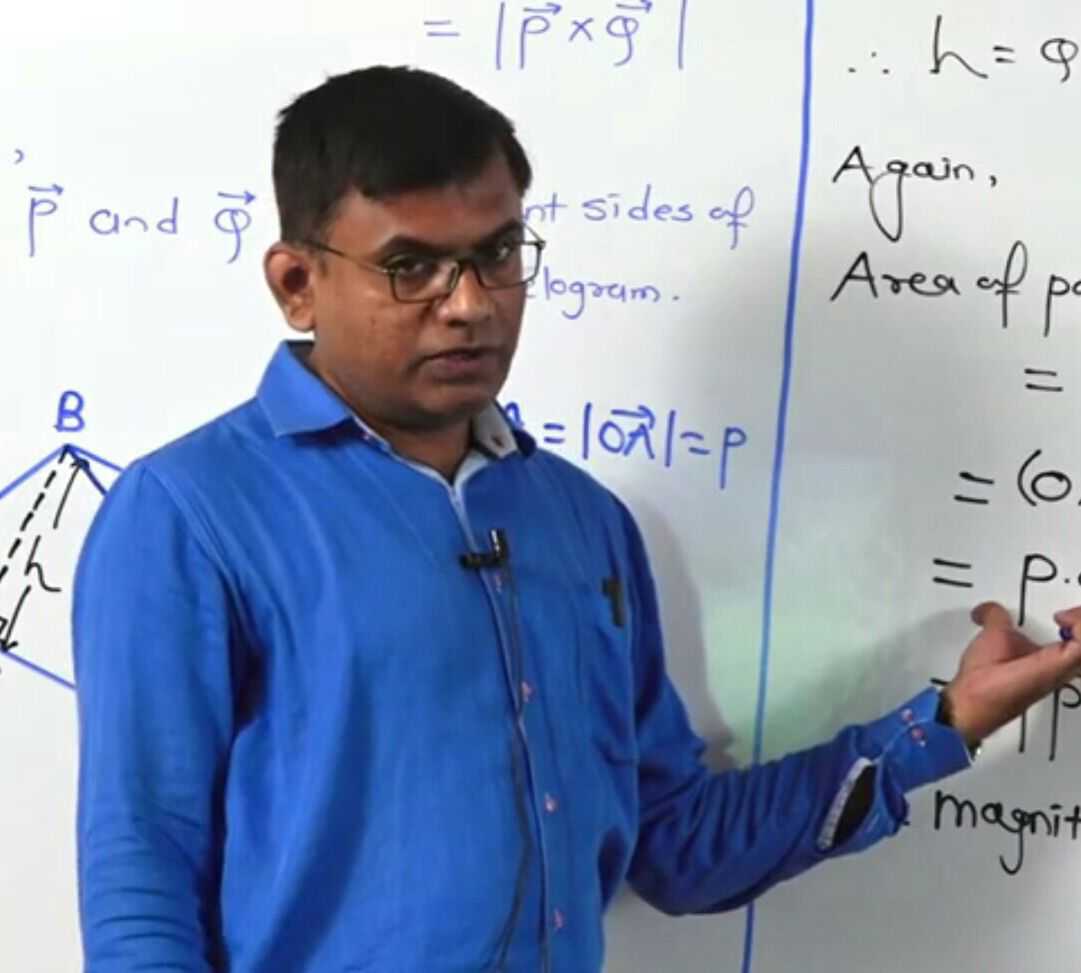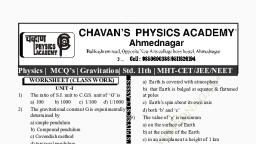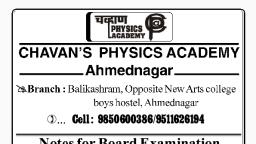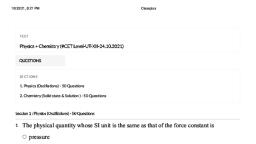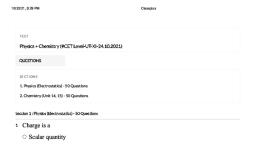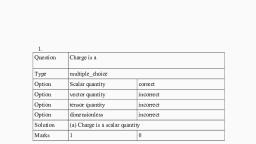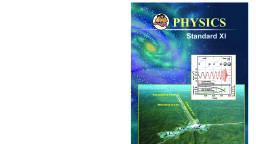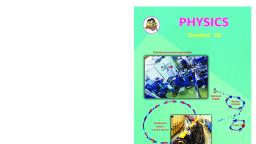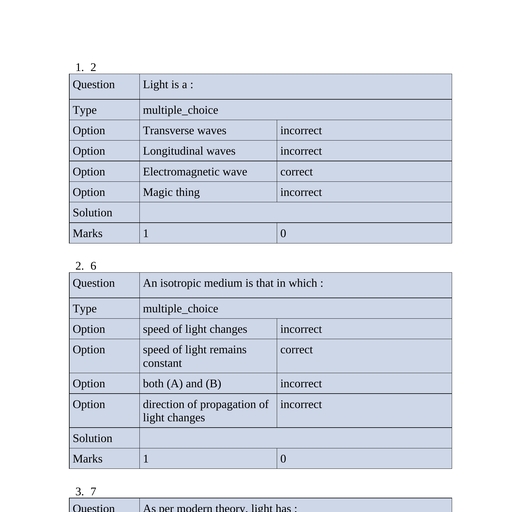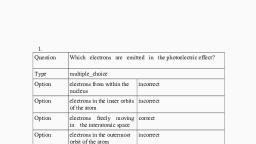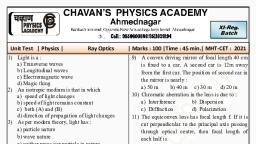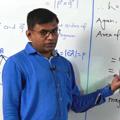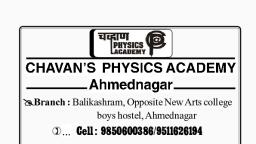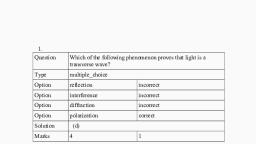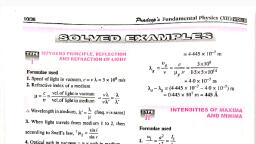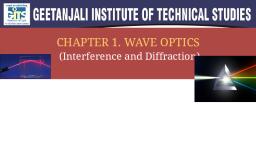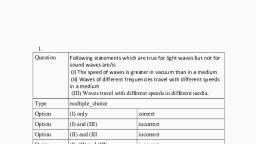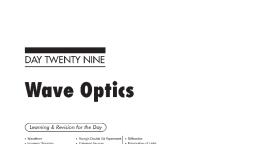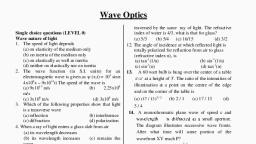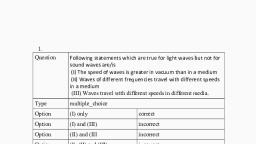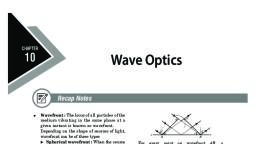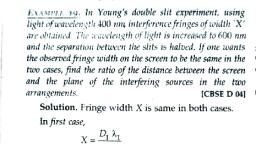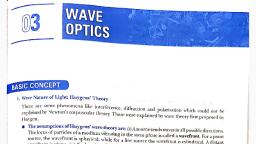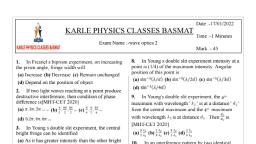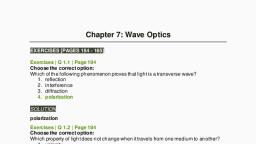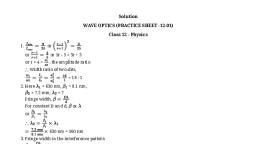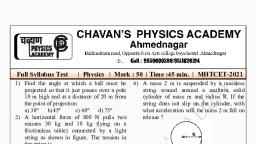Page 1 :
XII-Target, Batch, , Unit Test | Physics |Waves Optics| Marks: 100 | Time : 45 min. | MHTCET : 2021, 1), , 2), , 3), , 4), , 5), , 6), , 7), , 8), , Velocity of light in glass whose refractive index, with respect to air is 1.5 is 2, 108 m/s and in, certain liquid the velocity of light found to be 2.5 x, 108 m/s. The refrative index of the liquid with, respect to air is a) 0.64, b) 0.80, c) 1.20, d) 1.44., 0, A prism of refracting angle 60 is made with a, material of refractive index . For a certain, wavelength of light, the angle of minimum, deviation is 300. For this wavelength, the value of, of material is a) 1.820, b) 1.503, c) 1.414, d) 1.231., Width of a wavefront incident from air on to a, medium is 5 cm. in medium. What is width of wave, front in air. Given i = 600, r = 300., a) 5√3 cm b) 5/√3 cm c) 2.5 cm d) 10 cm., The beam of light has wavelength of 60000 A in air., Its wave number in glass of R.I. 1.5 will be, a) 2.5 107/m., b) 2.5, 104/m., c) 2.5 106 /m., d) 2.5 108 / m., The ratio of widths of incident wavefront in air and, refracted wavefront in a medium is 0.8. If the angle, of incidence is 450, the angle of refraction will be a) 240 54' b) 250 54' c) 280 54', d) 270 54', The refracting angle of the prism is 300. There will, be deviation of a monochromatic ray which has, incident normally on its one surface. This angle of, deviation will be ( = 1.5), a) 1800, b) 2201, c) 18036' d) 20030'., A ray of monochromatic light is refracted from air, to glass of RI 1.5. The angle of incidence is 450C., The angle of deviation is :, a) 450, b) 280, c) 170, d) 620, A glass prism has RI of 1.5 and refracting angle of, 900. If a ray falls on it at an angle of incidence of, 300, the angle of emergence will be :, a) 600, b) 40, c) 300, d) None of the above as the ray will not emerge due, to total internal reflection in the prism., , Unit Test, , 9), , A ray of monochromatic light is incident on a right, prism of RI 1.5 normally on the face AB as shown, in the figure. It suffers critical refraction on, emerging out of the prism. The angle of the prism, is :, A, , B, , 10), , 11), , 12), , 13), , 14), , 15), , 16), , C, , a) 400, b) 450, c) 420, d) 480, Monochromatic light of wave length 589 mm. is, incident from air to water surface. What is the, speed of the refrated light (R.I. for rate is 1.33), a) 2.25 108 ms-1, b) 5.09 108 ms-1, c) 2.25 106 ms-1, d) None of above., A ray of light is incident on the surface of a glass, plate of refractive index 1.55 at the polarising, angle. The angle of refraction is :, a) 00 b) 1470 111, c) 750111 d) 320 491, If a ray of light is incident on a plane mirror at an, angle of incidence of 350, then the deviation, produced by the mirror is, a) 350 b) 1100, c) 900, d) 550., A light wave has a frequency of 4 x 104 Hz and a, wavelength of 5 10–7 metres in a medium. The, refractive index of the medium is a) 1.5, b) 1.33, c) 1.0, d) 0.66., The refractive indices of glass and water w.r.t. air, are 3/2 and 4/3 respectively. The refractive index, of glass w.r.t. water will be a) 8 / 9 b) 9 / 8, c) 7/6, d) None, a = 1.6 ; a, g, g 2.4. Ratio of velocity of light in, glass to diamond is, a) 3.84, b) 0.8, c) 4/3, d) 3/2., A light wave of frequency 5, 1014 Hz enters a, medium of refractive index 1.5. In the medium, the, velocity of the light wave is ...... & its wavelength, is ......., a) 3 x 108 m/s, 6000 A0., b) 2 x 108 m/s, 6000 A0, c) 2 x 108 m/s, 6000 A0., d) 2 x 108 m/s, 4000 A0., Page 1
Page 2 :
17) The frequency of light in air is 4.5 x 1014 Hz. Its, frequency in diamond of R.I. 2.4 will be, a) 5, 1014 Hz., b) 4.5, 1014 Hz., c) 4, , 1014 Hz., , d) 3, , 1014 Hz., , 18) Monochromatic light of wavelength 6000 A0 is, incident from air on glass ( = 1.5). The frequency, of the refracted light will be, a) 5, 1014 Hz., b) 3.3, 1015 Hz., 1013 Hz., 19) Velocity of light waves in air is 3, 108 ms–1., When the light wave is refracted into a medium of, RI 1.5, the velocity of the wave in the medium is :, a) 2 108 ms-1., b) 4.5 x 108 ms–1., c) 5, , 1012 Hz., , d) 3.3, , c) 0.5 108 ms-1., d) 3 108 ms1, 20) If the velocities of a light wave in two media d and, f are respectively 2.25 108 ms–1 and 1 108 ms-1,, then the RI of medium f with respect to d is, a) 1.125, b) 0.88, c) 0.25, d) 1.5., 21) Find the frequency of green light in glass if its, wavelength in air is 6000 A0. Velocity of light in, air is 3 x 108 ms-1 R I of glas 1.5, a) 1014Hz b) 1013 Hz, c)1012Hz, , d)1011 Hz, 22) The frequency of light having a wavelength 3000, A0 is, a) 1015 cycles / sec., c) 3000 cycles / sec., , b) 9 1013 cycles / sec., d) 90 cycles / sec., 23) The frequency of light in air is 4.5 1014 Hz. Its, frequency in diamond of R.I. 2.6 will be, a) 5 1014 Hz, b) 4.5 1014 Hz, c) 4 1014 Hz, d) 3 1014 Hz, 24) For the reflection of light at the interface between, air and glass, the change of phase of reflected wave, is equal to a) zero, b) c, c) c/2, d) 2 c, 25) Two coherent light sources s1 and s2 ( =6000 A0), are 1mm apart from each other. The screen is placed, at a distance of 25 cm from the sources. The width, of the fringes on the screen should be a) 0.015 cm, b) 0.025 cm, c) 0.010 cm, d) 0.030 cm, 26) In a double slit interference experiment the distance, between the slits is 0.05 cm and screen is 2 m away, from the slits. The wavelength of light is 6.0 10–5, cm. The distance between the fringes is a) 0.24 cm b) 2.21 cm, c) 1.28 cm d) 0.12 cm, Unit Test, , 27) In a two slit experiment with monochromatic light,, fringes are obtained on a screen placed at some, distance from the slits. If the screen is moved by, 5 10–2 m towards the slits, the change in fringe, width is 3 x 10-5 m. If separation between the slits, is 10-3 m, the wavelength of light used is, a) 6000 A0., b) 5000 A0., c) 3000 A0., d) 4500 A0., 28) The distance of point on screen from two slits are, 1.8 10–5 m and 1.23 10–5 m. If wavelength is, 6 10–7 m. the number fringe formed will be, a) 8 th dark, b) 9 th dark, c) 10 th dark, d) 11 th dark, 29) The optical path difference between two light, waves interfering at a point is 29.45 micron. Which, of the following will be the wavelength used to, give dark illumination at that point? (n = 1), a) 5.69 10–7 m, b) 5.97 10–7 m, c) 5.89 10–5 m, d) 5.99 10–7 m, 30) In a biprism experiment, the wavelength of red, light used is 6450 A0 and that of green light used, is 5160 A0. What will be the value of n for which, the (n+1)th bright band for green light corresponds, to the nth bright band for red light for the same, setting?, a) 4, b) 3, c) 2, d) 40., 31) Two coherent sources of light having intensity, ratio 100 : 1 interfere. The ratio of intensities of, maxima to minima in the interference pattern will, be, a) 121 : 81 b) 101 : 99, c) 100 : 1, d) 10 : 1., 32) In Young's experiment, with the distance of 80 cm, between slits and screen, the band width was found, to 2 mm. This band width was found to be, increased by 10 % when the distance between slits, & screen was increased. The new distance between, slits and screen will be, a) 85 cm, b) 82 cm, c) 86 cm d) 88 cm, 33) In Young's two slits interference experiment, if the, slit is made threefold, the fringe width becomes, a) 1/3 fold b) 3 fold, c) 1/9 fold d) 9 fold, 34) In Young's experiment if d=1 mm, D=1 m, X=6, mm then wavelength of light used is, a) 6000 A.U., b) 4000 A.U., c) 5000 A.U., d) 4850 A.U., 35) In a biprism experiment, the band width is 0.4 mm, when the eye is at a distance of 1m from the slit. If, the eye is moved through a distance of 25 cm, towards the biprism without changing any other, arrangement, then change in fringe width is, a) 0.0001 mm, b) 0.001 mm, c) 0.01 mm, d) 0.1 mm, Page 2
Page 3 :
36) In a biprism experiment with yellow light, ( = 590 nm) 62 frings are obtained in a given, region. The number of fringes obtained with green, light, ( = 550 nm) will be, a) 52, b) 62, c) 67, d) 76., 37) Two waves having intensity ratio 9:1 produce, interference. The ratio of maximum to minimum, intensity is, a) 10 : 8, b) 9 : 1, c) 4 : 1, d) 2 : 1., 38) The path difference between two waves meeting at, a point 25.5 , where is the wave length of light., The point is :, a) Bright., b) Dark., c) Alternately bright & dark. d) None of the above., 39) The fringe width in young's experiment is 0.4mm, for a certain source when the screen is at a distance, of 100 cm from the slits. If the distance of screen is, increased to 150 cm, other things remaining same,, the new fringe width is, a) 0.3 mm. b) 0.4 mm. c) 0.5 mm. d) 0.6 mm., 40) In Young's experiment the two slits are separated by, a distance of 4 mm. The screen is at a distance of, 100 cm from the slits. If the distance of the 20th, bright band from the central bright band is 2.5 mm, the wavelength of the light is :, a) 4800 AU., b) 4900 AU., c) 5000 AU., d) 5100 AU., 41) The path difference between two waves meeting at, a point is (11 /4). The phase difference between, the two waves at the same point is :, a) 11 / 4, b) 2, c) 22, d) 11 /2, 42) Two waves whose equations are Y1=4 sin( t + /2), and Y2= 3 cos t superimpose at a point. The, resultant displacement at the point is :, a) 1 unit, b) 7 unit, c) 5 unit, d) unit, 43) Two slits are spaced 0.3 mm apart and are placed 50, cm. from a screen. What is the distance between the, second and third dark lines of the interference, pattern. When the slits are illuminated with light of, 600 nm. wave length 1nm = 10-9m, , 45) In young's double slit experiment, we get 60 fringes, in the field of view of monochromatic light of, wavelength 4000 A0, If we use another, monochromatic light of wavelength 6000 A0, then, the number of fringes obtained in the same field of, view is a) 1.5, b) 90, c) 60, d) 40, 46) The distance between slits in the Young's, experiment d=10-3 m. Distance between slit and, screen D=3.0 m, width of the bands is seen, 2.1 10–3 m. The colour of the light used is a) Violet, b) Green, c) Yellow d) Red., 47) In a biprism experiment, using light of wave length, 5000 A0, A 5 mm wide fringe are obtained on a, screen 1.0 m away from coherent sources. The, separation between the two coherent sources is a) 1.0 mm, b) 0.1 mm, c) 0.05 mm, d) 0.01 mm., 48) The ratio of amplitudes of two separate light waves, producing interference is 3/2. The ratio of, intensities of maxima and minima will be a) 1/25, b) 25/1 c) 1/2.5, d) 0.25/1., 49) When a light of wavelength 5000 A.U. passes, through a liquid of R.I. 1.25, change in, Wavelength is equal to, a) increase of 1000A.U. b) decrease of 1000 A.U., c) decrease of 1250A.U. d) decrease of 625A.U., 50) In Young's double slit experiment, the separation, of four bright frings is 2.48 mm when the, wavelength used is 6.2 10–7 m. If the distance, from the slits to the screen be 0.80 m, the, separation of the two slits will be, a) 0.8 x 10-3 m., b) 0.4 x 10-3 m., c) 0.8 x 10-2 m., , d) 0.4 x 10-2 m, , a) 1 mm, b) 2 mm, c) 3 mm, d) 4 mm, 44) The optical path difference between two light waves, interfering at a point is 29.75 mm. Which of the, following will be the wavelength used to give dark, illumination at that point ? (n = 50.5), a) 5.69 10–2m, b) 5.95 10–4m, c) 5.89, Unit Test, , 10–7m, , d) 5.99, , 10–7m, Page 3
